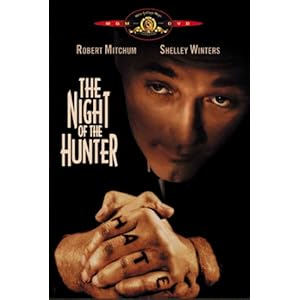
NIGHT OF THE HUNTER: THE MOVIE
Night of the Hunter is a strange little movie—and I mean that in the best possible way. It’s a few different movies wrapped in a few different genres in a few levels and succeeds in all of them. Yes, I definitely enjoyed this month’s book vs. movie a whole lot more than The Mephisto Waltz.
On one level, this movie is about the hunted, in this case two small children. Their father, a murdering thief, stashed $10,000 in a place only they knew of. A fellow prisoner finds out about this and, upon his release, weasels his way into the family in hopes of scoring the cash. This taps into the fears of so many kids who are faced with a “new daddy” upon their mother’s remarrying. Sure, they may be smiling on the outside, but there is an uneasy feeling about the person who they are told will replace the original and beloved parent.
This movie is also about the Hunter, portrayed in this one by Robert Mitchum. I don’t think I’ve seen him in a more melodramatic role. Every word, every nuance, just oozes with sleaze and slime. So much so that you wonder how most of the characters don’t notice, and instead get sucked into his charm. Yes, the performance was over the top but you can’t help be fascinated by Mitchum’s sinister minister Powell.

Which brings me to another aspect of this movie—the pure melodrama. The characters are all defined by one ideal—Pearl, the sister, is naiveté, the mother is blissful ignorance, Powell is greed, the brother John is loyalty, the neighbor is meddling, their eventual caretaker is nurturing. Every character seems to be, not a person, but a symbol. And yet, somehow it works.

There is a level of surrealism to Night of the Hunter. This was director Charles Laughton’s only movie. Most of his experience was in the theatre, and it is quite apparent in the look of the film. The sets are minimal, like stage decorations meant to show the most scenery in the fewest parts. For example, a shot of them on a boat drifting down a lake will have the lake, the boat, the characters, and the rest in silhouette. We don’t need to see every reed lining the water, so Laughton doesn’t bother with it. This kind of “just enough to get the point across” fits in perfectly with his characters—they are who they need to be to get the story to the next part.
It is most definitely a horror story. Powell is as much of a menacing, stalking murderer as Freddy or Jason, and yet he is more terrifying because he is human. Two dimensional, sure, but human nonetheless. The fact that his intended victims are innocent children makes it that much more horrific.

And at the end it becomes a whole different story altogether. While on the run the children come upon an older woman (beautifully played by Lillian Gish) who takes care of a house full of foster children. No longer is the tale about John, Pearl and Powell, but about Mrs. Cooper, and the lengths she will go to for her wards. It is then that the movie finally comes full circle and moves from being a film about the effects of evil but then the effects of good.
I cannot do this movie justice in the few small paragraphs I have just typed. Laughton did a perfect job in finding the balance needed for this story. There is not a wasted shot or useless piece of dialogue, and yet he managed to make the movie without cheating the viewer of a single thing. I would definitely recommend Night of the Hunter, not just to fans of scary movies, but to anyone who respects film as a storytelling medium.
--Jenny

NIGHT OF THE HUNTER - Book
This was Davis Grubb’s first novel, and he used it to tell, in the classical novel format, a story of the difficulties of children during the depression. The book is told primarily through the eyes of the boy, John, and deviating in the final part to focus almost equally on the teenaged girl Ruby. For scenes where neither of these characters was present, Grubb would present the action in a way which would have been in keeping with a youthful interpretation of events, as if John or Ruby were watching and cataloguing what was happening.
The lack of quotation marks and associated punctuation is at first distracting, and it eventually becomes merely a minor stylistic annoyance, used to normalize the near-constant intermingling of observation and unspoken thoughts from the boy. It proves to be worthwhile at the end of the book, however; John’s final internal monologue is made powerful and disturbing by the format.
The “Love” and “Hate” knuckle words… now a part of cultural history… saw their first appearance in this book, where the Preacher argues on the constant war between “Left hand Hate” and “Right hand Love”. John’s view of this, as fingers of evil, not words but just letters on both hands, allows for a few great scenes of John’s thinking.
The book holds its own against the movie by taking advantage of the writer’s ability to present what is inside the minds of his characters. It also fleshes out many of the scenes from the movie, giving the story more cohesion. Lacking great performances by actors and actresses, it relies instead on storytelling and characterization, and it succeeds very well.
It is, by turns, a thriller, a horror story, and a novel of despair. It is also strangely appealing as a historical piece due to the decades removed since its writing.
Four stars out of five.
--Bill
